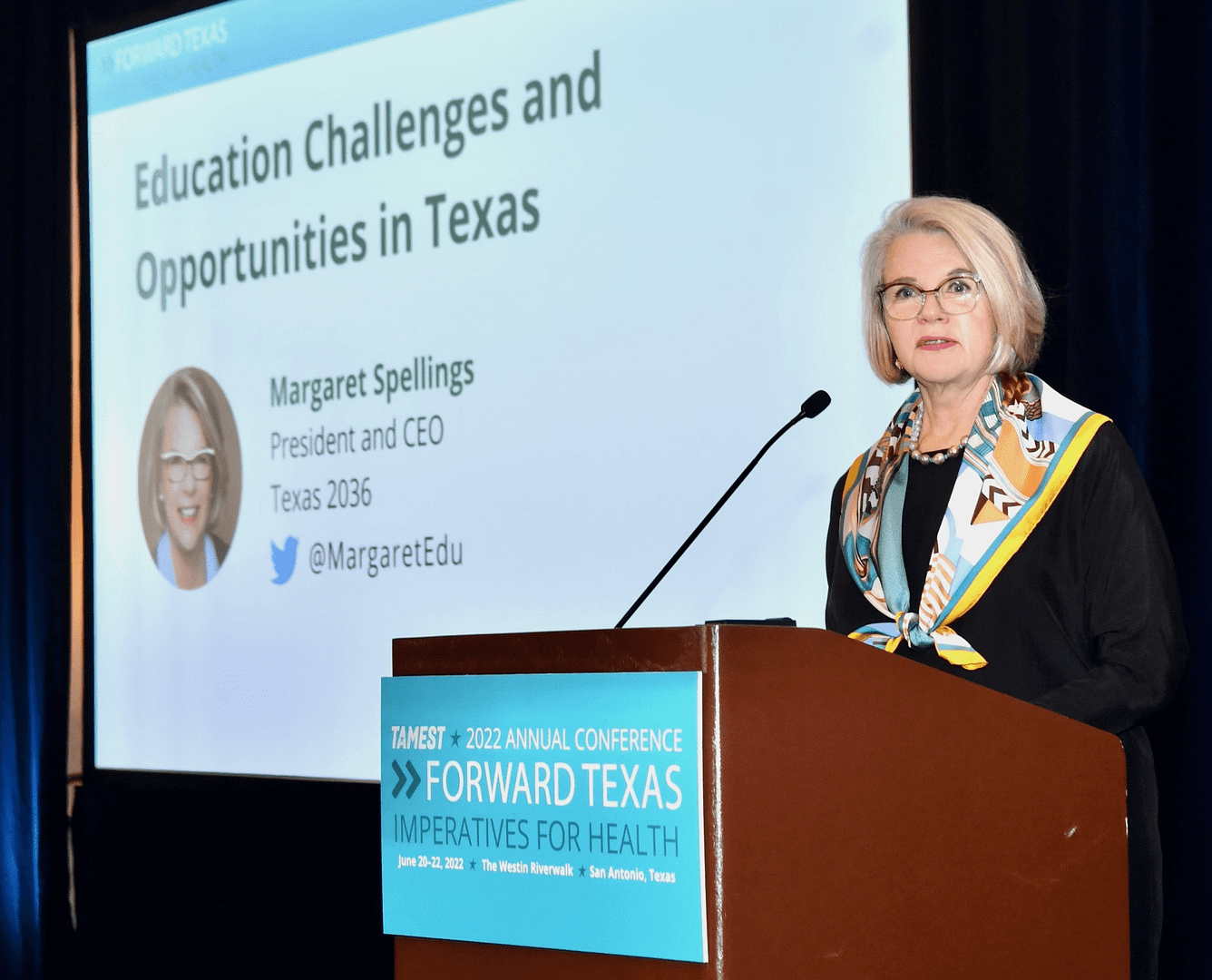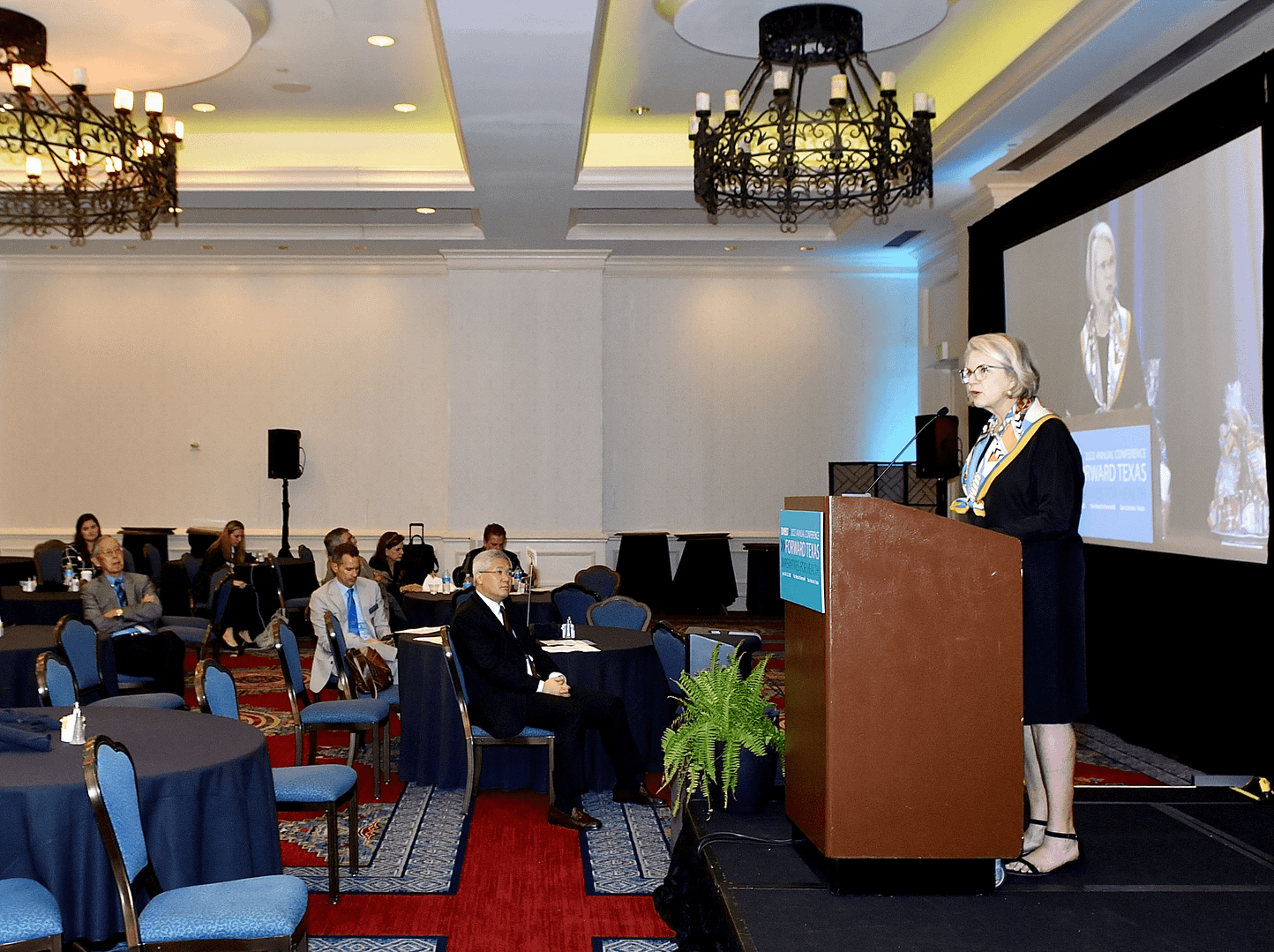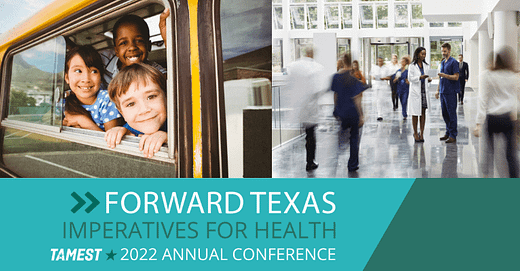Texas 2036 CEO Margaret Spellings Delivers Keynote to State’s Top Health Care Leaders
The following remarks were delivered by Texas 2036 President and CEO Margaret Spellings during her keynote speech at “Forward Texas: Imperatives for Health,” Texas Academy of Medicine, Engineering, Science and Technology’s (TAMEST) Annual Conference, on June 22, 2022 in San Antonio, Texas.
It’s a great honor to speak before this prestigious audience of our state’s top health care leaders and some of the brightest minds in our country.
I have the privilege of leading Texas 2036, the nonpartisan, non-profit organization building long-term, data-driven strategies to help secure our state’s prosperity through our bicentennial and beyond.
Our bumper sticker on how we’re approaching this bold mission is that “we’re working to bring together the sensible center to think long-term about the most important things using tons of data.”
Admittedly a long bumper sticker.
Our work includes the full spectrum of policy areas, including education and workforce, health care, infrastructure, natural resources, justice and safety and state government performance.
And one of our key differentiators at Texas 2036 is the hundreds of data sets we use to ground our policies and make that information available to policymakers and the public.
A theme running through our work are the opportunities and challenges given our rapid population growth.
Texas added more than four million people between 2010 and 2020 and about 400,000 more just last year. Over the next 14 years through 2036, we can expect as many as 10 million more, bringing our population to 40 million.
 Which leads us to the central question I am here to discuss today — are we prepared to successfully equip millions of students and the generations who follow with the knowledge and skills to earn self-sustaining jobs, provide for their families, contribute to civic life, and enjoy the American dream?
Which leads us to the central question I am here to discuss today — are we prepared to successfully equip millions of students and the generations who follow with the knowledge and skills to earn self-sustaining jobs, provide for their families, contribute to civic life, and enjoy the American dream?
And the answer, my friends, is that the prognosis is not good unless we take decisive action to correct course and fast (We don’t have time to waste!).
Texas students have fallen behind their peers in other states on the fundamental building blocks of a good education — reading and math. Sadly, Texas dropped eight places from 37th in fourth grade reading on the national assessment in 2005 to 45th in 2019. And fewer than half of Texas third graders are on grade level in reading or math today.
And while many of you might think that your local public school is different, the truth is, it’s probably not doing nearly as well as you think. For example, at one of the most prestigious school districts here in San Antonio — twenty-one percent of students in the district failed the state’s math test and another quarter “passed” but will require additional instruction and help to succeed. This means that almost half — 47 percent — of students at one of the best school districts in our state will require additional help to perform at grade level in math next school year.
And what do you think happens when this district’s students graduate from high school? Many of them come from wealthier families with a history of higher education. But the most recent data available shows that 86 percent of high school graduates enrolled in college, which sounds promising, until we follow the data to learn that only about half graduated with a degree or credential within six years.
What may surprise you is that these scores — producing so few credentialed students — are some of the better ones and demonstrate how challenging the situation is for students statewide.
For low-income and minority students, the situation is much worse. They are continually stuck in failing schools often without access to good teachers, rigorous curricular materials, or the type of support that they need to thrive, and this has led to dire outcomes. For example, at one Austin middle school, ONLY three percent of students do math at grade level and seven percent are on grade level in science.
Across Texas, 60 percent of all students — about three million — are from economically disadvantaged homes. Only 33 percent of these students are at grade level in reading and only 26 percent at grade level in math. These outcomes should be unacceptable to all of us and are honestly appalling. Shouldn’t the expectations we have for any child in Texas match the expectations we have for our own children?
These dramatic disparities highlight the need for a robust diagnostic system that includes assessment and accountability to help ensure our schools get students on track for success — or at least on grade level. We must tell the truth about student achievement and hold ourselves responsible for those results.
So, it’s concerning when some groups and some legislators are fighting to reduce standards and eliminate the measurement that allows us to see where our kids are especially since the pandemic. We must care enough to find out, even when results are disappointing and make sure that complacency or “the soft bigotry of low expectations” — as my former boss used to say — does not stop Texas from accountability and action.
Whether under the guise of local control or local politics, the arguments being made to disconnect performance from the valid data we collect creates a school system without the information to improve the enterprise and resource the challenges. Unfortunately, this is a phenomenon on both sides of the aisle and sadly has created a threat to generations of students.
In the 1990s and early 2000s, Texas led the nation in implementing rigorous standardized assessment and accountability, which resulted in Texas charting a path of better outcomes. At that time, the statewide math scores grew by 14 percent within six years.
In the late 2000s, sadly, Texas reversed course and took steps to weaken this approach. And clearly, we’re seeing the impact on student achievement now.
That’s why in 2019, the Texas legislature worked to address the slide in school performance by passing House Bill 3, a sweeping and historic school finance bill, which provided more money for Texas classrooms and increases in teacher pay. Unfortunately, the pandemic has slowed progress, but the data-driven system it created — if left intact has tremendous potential to improve our schools.
 This is not the time to back away from reforms that generated widespread bipartisan support. Nor is it time to back away from the test that these reforms are built on — despite what you may have heard, the STAAR test is written and reviewed by Texas teachers, endorsed by psychometricians and other experts, and aligned with other measures like the National Assessment of Educational Progress or NAEP. Thanks to Education Commissioner Mike Morath, STAAR has also recently undergone significant improvements to better align the test to the classroom experience and allow for it to be administered online to get information to students, their parents, and teachers more quickly.
This is not the time to back away from reforms that generated widespread bipartisan support. Nor is it time to back away from the test that these reforms are built on — despite what you may have heard, the STAAR test is written and reviewed by Texas teachers, endorsed by psychometricians and other experts, and aligned with other measures like the National Assessment of Educational Progress or NAEP. Thanks to Education Commissioner Mike Morath, STAAR has also recently undergone significant improvements to better align the test to the classroom experience and allow for it to be administered online to get information to students, their parents, and teachers more quickly.
In medicine, lives would be at stake if patients blamed the test for poor outcomes, instead of working with their medical teams to focus on treatment and recovery. Some of you may recall a quote by our former President Trump about COVID testing: “If we stop testing, we’d have fewer cases.” This strategy didn’t make sense for COVID, and it doesn’t make sense today.
The stakes are high. If Texas fails to address students’ COVID learning loss, one study predicts our state will lose more than $1 trillion in economic activity over these students’ lifetimes.
The good news is that we know what to do.
One key to success is the quality of our curricular materials. Commissioner Mike Morath has also spoken about the importance of “increasing the rigor of the content students learn.” I agree. Besides the teacher in the classroom, a critical aspect is the quality of our instructional materials. This means more materials with research-based track records of improving student outcomes for all learners, so we don’t waste valuable time.
We must raise our expectations for our teachers, our students, and ourselves. We need more rigor through advanced coursework, like AP and IB. And we need to be innovative about ensuring these opportunities are available to all Texas students regardless of their income or location by closing the digital divide and leveraging new technologies.
The good news is that with available federal funds and legislative budget commitments, we HAVE the resources and the expertise to meet the moment. All we need is the will and expectations that we do.
But, as all of you know who are here today, education doesn’t end with the high school diploma. In your case, high school graduation was only the beginning of a long journey. However, it won’t surprise you given our low reading and math outcomes, that’s where Texas education ends for most of our students.
Historically, Texas has overcome these shortfalls through domestic and international migration, with well-educated people moving to our state to fill jobs and create a better life. But migration patterns are volatile, have slowed periodically and cannot be relied on to meet our state’s future needs, especially as we leave so many others behind.
The Texas economy as a whole — and the health care industry in particular — depends on a highly educated workforce with the specialized knowledge and skills required for jobs transformed by rapidly emerging advancements in technology.
And that is why many, including Texas 2036, are supporting the calls for the next legislative session to become a workforce session, focused on what we can do to ensure Texans have the skills that employers, including those in health care, so desperately need.
Last year, every Texas county except for five — that’s 249 out of 254 — had a primary care physician shortage. Last week, the Texas Workforce Commission announced a critical shortage of 20,000 registered nurses.
At the same time, demand for health care occupations is expected to grow faster than all other occupations combined. The most recent projections show health care employment in Texas will grow almost 19 percent by 2028, requiring an additional 190,000 skilled workers.
Sadly, Texas is not yet organized for success in achieving our future workforce needs.
Despite spending more than $100 billion per year on education and workforce programs, an unsustainable skills gap is growing. 90 percent of Texas students graduate high school, but only 72 percent seek a post-secondary degree or credential and only 32 percent ultimately earn a credential within six years of graduating, but more than 70 percent of jobs in Texas will require one in the next 14 years.
Last session, Texas 2036 and a coalition of businesses, chambers and other organizations created Aim Hire Texas and supported legislation to create a more effective process for the state to tackle workforce challenges and better align education-and-workforce silos.
To achieve these goals, Texas has launched Building a Talent Strong Texas, which will work toward 60 percent of all Texans by 2030 earning a “credential of value” — those that have a proven, positive economic return for students.
This, of course, must be translated to better policies and supports at higher education institutions. Our universities, community and technical colleges are working to support programs leading to high demand credentials in line with key industries, including health care. They’re supported by grants like the Texas Reskilling and Upskilling through Education, or TRUE program. These grants are helping stand up short-term programs that can be completed in six months or less and provide efficient paths towards careers in fields like nursing and medical technology.
Work to improve completion is also happening at the Community College Finance Commission appointed by the legislature to study better resourcing and incentives for colleges to better meet employer needs.
Through Building a Talent Strong Texas, credentials of value will include transfer pathways to further education, providing students who may think they can only afford a community or technical college education a cost-efficient path towards a bachelor’s degree or greater.
 Building a Talent Strong Texas also reintroduces research goals for higher education institutions, calling for increased research funding and more post docs across our state’s diverse demographics. This is how we will produce more research with real-world value, like we see when a pair of Houston scientists develop a patent-free, low-cost COVID-19 vaccine that can be easily accessed and used worldwide — just one of the many examples we could give.
Building a Talent Strong Texas also reintroduces research goals for higher education institutions, calling for increased research funding and more post docs across our state’s diverse demographics. This is how we will produce more research with real-world value, like we see when a pair of Houston scientists develop a patent-free, low-cost COVID-19 vaccine that can be easily accessed and used worldwide — just one of the many examples we could give.
Texas’ major health and life science research hubs have been built around major academic institutions, especially in Houston, Austin, Dallas, and San Antonio. These are important economic and innovation engines for our state with strong PhD talent, like bioengineers, biochemists, microbiologists, and scientists.
To help recruit Nobel laureates and members of national academies from other states, Texas has relied upon an economic development incentive program called the Governor’s University Research Initiative. And while it’s smart to pay accomplished people to move here, we also must find better ways to do more for Texas students — any one of whom could be the one to earn the next Nobel Prize.
To create the pipeline of academics, innovators, and researchers, we’ll need to support the continued alignment of the academic, commercial, and medical sectors around future workforce needs, as we’ve been seeing in the Texas Medical Center in Houston, the Dell Seton Medical Center in Austin, the UT-Southwestern Medical Center in Dallas, and the UT Health Science Center in San Antonio — to name a few.
We also need to build a large enough pipeline for other health care workers by ensuring we have enough educators and trainers — which means paying them enough — and making sure that training is accessible and affordable.
Nursing schools and hospitals, both of which want to increase the number of students going through nursing programs, are stuck in a loop: Nurses in understaffed units can’t take on as many nursing students because of how much work they have, limiting the number of students nursing schools can accept. Fewer nursing school graduates in turn makes it more difficult to staff at appropriate levels.
To combat this cycle, the Texas Workforce Commission announced earlier this year that $15 million in funding will be allocated to a statewide apprenticeship initiative with the goal of expanding opportunities for people interested in nursing, including helping students to complete registered apprenticeship programs that earn college credit.
This program demonstrates the potential we have when we more closely follow the data and long-term workforce trends and find ways for the state to partner with regions, industries, universities, and schools to build the education-to-workforce pipeline we sorely need.
To get to where we want to be as a state will not be easy in this political environment. That’s why I started with our bumper sticker mission about bringing together the sensible center to think long term about the most important things using tons of data.
To do that, we need all of you to build the civic demand for the issues that matter the most. And I encourage you to introduce yourselves, add your name to our email lists and join one of our policy advisory groups or future events.
And for those who want to do more, I’ll leave you with a starting assignment:
Last week, the state started rolling out this year’s STAAR test results. As they are released, I want you to look at how students performed not just across the state, but in your neighborhood schools. And I want you to ask yourself if these are acceptable to you. And I want you join me in having the difficult conversations in your communities that are necessary if we are going to give our students — and ourselves — a fighting chance for a better future.
Thank you.
